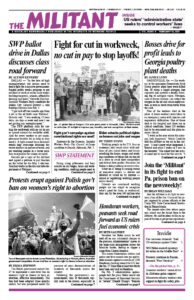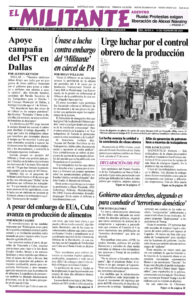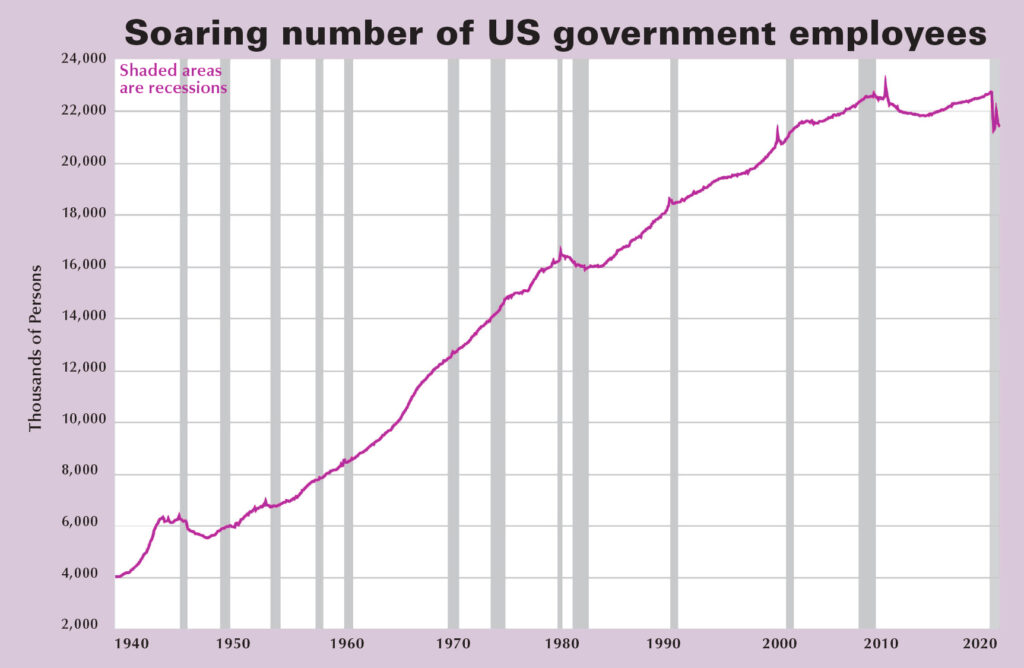Starting out his presidency by issuing a swath of executive orders, Joe Biden, like Barack Obama, Bill Clinton and Donald Trump before him, is strengthening the administrative state, an intrinsic part of modern U.S. capitalist rule. Through thousands of federal rules and regulations, liberals especially aim to browbeat and control the lives of workers. They think working people cannot be trusted to know what is in their own interests.
The propertied rulers exercise their state power not only through the courts, military and police, but through a massive administration of nonelected agencies. Connected to the proliferation of this bureaucracy is a shift from the legislative branch of government to the executive office of the president.
“The expanding concentration of power in the hands of the presidency — including the de facto power to declare wars, and to bypass legislation and debate by issuing Executive Orders,” writes Steve Clark in the introduction to the Pathfinder book Are They Rich Because They’re Smart? “is dangerous (ultimately a bonapartist threat) to the interests of workers, working farmers, and the labor movement.”
In his first nine days in office Biden has signed 42 executive orders, instead of placing these issues before Congress to debate and rule on.
The Biden administration is the political continuation of the presidencies of Bill Clinton and Barack Obama. “I’ve got a pen and I’ve got a phone,” Obama announced in 2014, telling legislators if they don’t vote for his agenda, he’ll issue executive orders anyway.
And he did. Between 2009 and 2017, Obama issued 276 executive orders. Clinton during his terms from 1993 to 2001 issued 308 presidential decrees. Donald Trump issued 220 presidential decrees during his four years in office.
The growth of government regulatory agencies that impose rules and restrictions on the lives of working people is an ever-increasing part of capitalist rule. This administrative state has its roots in the rise of monopolies and imperialist domination by the wealthiest capitalist powers in the early 1900s. This trend has accelerated exponentially since World War II.
There are 605 U.S. government agencies and departments today, employing 730,300 at the Department of Defense; 363,400 at the Department of Veteran Affairs; 186,400 at the Department of Homeland Security; and 113,000 at the Department of Justice.
The number of U.S. government employees has increased from 4 million in 1939 to 21.4 million at the end of last year. And this doesn’t count the CIA and other secret police, whose numbers are kept under wraps. While this includes postal, transportation and hospital workers who operate services of value to working people, most are employed by agencies aimed at maintaining and defending social relations of exploitation and oppression.
In 2015 the Code of Federal Regulations totaled 178,277 pages in 237 volumes. The Obama administration in 2016 added over 97,000 pages to the Federal Register, an all-time record, including thousands more rules and regulations, reported Forbes magazine. That year agencies issued 18 times as many rules than laws that were voted on by Congress.
Courts will not protect you from the ever-expanding reach of this burgeoning apparatus. In 2019 a Supreme Court ruling reaffirmed that lower courts should defer to federal agencies’ interpretations of their own regulations and not rule against them.
The increasing number of government agencies has been accompanied by a rapid growth in nongovernmental organizations, “think tanks” and foundations, often funded by wealthy capitalists. About 1.5 million NGOs operate in the U.S., according to the State Department, largely formed in the past 30 years. Most are tied to government agencies or are used by the U.S. rulers to advance their goals.
A social layer encompassing millions of self-styled “meritocrats,” who see themselves as arbiters over the lives of the “deplorables,” runs the administrative state and its many appendages.
“Their existence is more and more alien to the conditions of life of working people,” writes Jack Barnes, Socialist Workers Party national secretary, in Malcolm X, Black Liberation, and the Road to Workers Power. “Its members truly believe that their ‘brightness,’ their ‘quickness,’ their ‘contributions to public life’ … give them the right to make decisions, to administer society on behalf of the bourgeoisie — what they claim to be on behalf of the interests of ‘the people.’”
This liberal meritocracy seeks to promote greater dependency among working people on the government and its administrative agencies. But the opposite is what workers need.
We need to advance our own struggles through which we gain confidence in ourselves and the capacities of our class. The working-class movement as it unites and fights for political power will overthrow and dismantle this repressive and administrative bureaucracy.
Oppose ‘big government’
Contrary to what the government and its apologists tell us, communists are opposed to “big government.” Our goal is to put the power directly into the hands of workers and farmers, not some gargantuan bureaucracy.
Writing on the lessons of the Paris Commune in 1871, where the working class took political power into its own hands for the first time, Karl Marx said, “The Commune made that catchword of bourgeois revolutions, cheap government, a reality by destroying the two greatest sources of expenditure — the standing army and the state functionarism.”
V.I. Lenin’s last fight before his death in 1924 was against growing bureaucracy in the Soviet Union, which culminated in a counterrevolution led by Joseph Stalin that overturned the Bolshevik revolutionary program.
As we fight in our millions to take power, transforming ourselves as we do so, we will confront the social crises humanity faces together.


